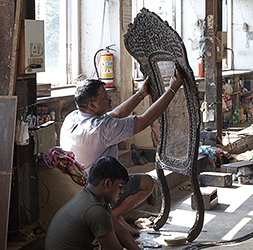“Once he was presented with something, it was a veritable game of ‘hide and seek’. The furniture did its best to disguise itself; however Mahendra Doshi looked right into the heart of the piece, captured it and blew life into [it].” (Relin H, “A Tribute to Mahendra Doshi”, The Inside Track, 15 July 2010, p. 12) Mahendra Doshi was born in Rajkot in 1943, where he was surrounded by 19th century antiques and objets d’art in his grandfather’s colonial bungalow. Growing up, he considered these pieces as his “subliminal orientation”. (Gaurav Bhatia, “A Cabinet of Curiosities”, Architectural Digest, May-June 2013, p. 120) In the 1960s, Doshi’s family moved to Mumbai where his father started a construction business. A decade later, Doshi joined him. It was during this time, in the mid-1970s on a construction site visit, that Doshi saw a French-style Lady Petit bungalow in the affluent Breach Candy locality of Mumbai being demolished. “Something called out to him as he saw beautiful Baccarat chandeliers, a large billiard table with ivory balls, a mini theatre with fabulous Chinese embroidery-work curtains being ripped apart and sold to the jari puranawallas (junk dealers).” (Bhatia, p. 120) As someone who loved antique furniture, he felt the need to intervene. From the ruins of this house, he rescued a sculpture of the Roman God Neptune. And thus began, Mahendra Doshi’s first step into the world of restoration. 
From there on, Doshi made frequent trips to Chor Bazaar, salvaging neglected, dusty and broken down pieces of period furniture. He often approached dealers and asked them to go to different parts of the country and recover hidden treasures of furniture for him. Over time, Doshi built a strong network of antique dealers, that today “spans from West Bengal to Gujarat and Goa to Kerala”. (Roshni Nair, “From Here to Antiquity”, DNA India, 28 September 2014, online)
Doshi’s first foray into restoration began with his own house. In Chor Bazaar, he had discovered a plethora of old, rejected furniture for his new apartment, which he hired a small team of carpenters, led by one Karsanbhai, to repair. “Once his flat was ready, Mahendrabhai realized, much to his chagrin, that it was too small to house his painstakingly restored treasures. He placed a small ad in the papers about antique restored furniture for sale, and the response was overwhelming. ... Soon, his wavering interest in the family’s construction business led him to do small projects for friends. It was Karsanbhai who then encouraged Mahendrabhai to make it a full-fledged business, a fact that Mahendrabhai has always credited him for.” (Bhatia, pp. 120, 122) |